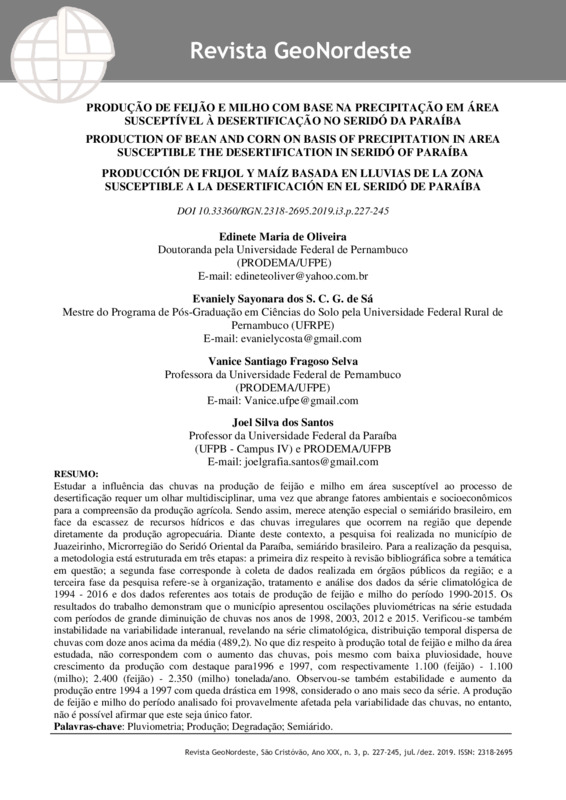PRODUÇÃO DE FEIJÃO E MILHO COM BASE NA PRECIPITAÇÃO EM ÁREA SUSCEPTÍVEL À DESERTIFICAÇÃO NO SERIDÓ DA PARAÍBA :
Item
-
Título
-
PRODUÇÃO DE FEIJÃO E MILHO COM BASE NA PRECIPITAÇÃO EM ÁREA SUSCEPTÍVEL À DESERTIFICAÇÃO NO SERIDÓ DA PARAÍBA :
-
Revista GeoNordeste
-
Autor
-
Edinete Maria de Oliveira
-
Evaniely Sayonara dos S. C. G. de Sá
-
Vanice Santiago Fragoso Selva
-
Joel Silva dos Santos
-
Abstract
-
Resumo
Estudar a influência das chuvas na produção de feijão e milho em área susceptível ao processo de desertificação requer um olhar multidisciplinar, uma vez que abrange fatores ambientais e socioeconômicos para a compreensão da produção agrícola. Sendo assim, merece atenção especial o semiárido brasileiro, em face da escassez de recursos hídricos e das chuvas irregulares que ocorrem na região que depende diretamente da produção agropecuária. Diante deste contexto, a pesquisa foi realizada no município de Juazeirinho, Microrregião do Seridó Oriental da Paraíba, semiárido brasileiro. Para a realização da pesquisa, a metodologia está estruturada em três etapas: a primeira diz respeito à revisão bibliográfica sobre a temática em questão; a segunda fase corresponde à coleta de dados realizada em órgãos públicos da região; e a terceira fase da pesquisa refere-se à organização, tratamento e análise dos dados da série climatológica de 1994 - 2016 e dos dados referentes aos totais de produção de feijão e milho do período 1990-2015. Os resultados do trabalho demonstram que o município apresentou oscilações pluviométricas na série estudada com períodos de grande diminuição de chuvas nos anos de 1998, 2003, 2012 e 2015. Verificou-se também instabilidade na variabilidade interanual, revelando na série climatológica, distribuição temporal dispersa de chuvas com doze anos acima da média (489,2). No que diz respeito à produção total de feijão e milho da área estudada, não correspondem com o aumento das chuvas, pois mesmo com baixa pluviosidade, houve crescimento da produção com destaque para1996 e 1997, com respectivamente 1.100 (feijão) - 1.100 (milho); 2.400 (feijão) - 2.350 (milho) tonelada/ano. Observou-se também estabilidade e aumento da produção entre 1994 a 1997 com queda drástica em 1998, considerado o ano mais seco da série. A produção de feijão e milho do período analisado foi provavelmente afetada pela variabilidade das chuvas, no entanto, não é possível afirmar que este seja único fator.
Palavras-chave: Pluviometria; Produção; Degradação; Semiárido.
ABSTRACT:
Studying the influence of rains on the production of beans and maize in area susceptible the desertification process requires a multidisciplinary view, once, covering environmental and socioeconomic factors for understanding of agricultural production. Therefore, the Brazilian semiarid region deserves special attention due to the scarcity of water resources and the irregular rains occurring in the region that depend directly on agricultural production. In this context, this research was carried out in the municipality of Juazeirinho, Microregion of the Seridó Oriental in Paraíba, semiarid region of Brazil. For the accomplishment of the research, the methodology is structured in three stages: the first one concerns the bibliographical revision on the subject in question; the second phase corresponds to the collection of data from public agencies in the region; and the third phase of the survey, refers to the organization, processing and analysis of data from climatological series 1994-2016, and the data on total production of beans and maize of the period 1990 - 2015. The results show that the municipality presented oscillations rainfall in the series studied with periods of great rainfall decrease in the years 1998, 2003, 2012 and 2015. Checked also an instability in yearly inter variability, revealing in the climatological series, dispersed temporal distribution of rains aged twelve years above the mean (489.2). The total production of beans and maize of the studied area do not correspond with the increase of the rainfall, because even with low rainfall, there was a growth of production with highlight to 1996 and 1997 with 1,100 (beans) -1,100 (maize) respectively; 2,400 (beans) - 2,350 (maize) tons per year. Observed also stability and increased production between 1994 and 1997, with a drastic fall in 1998, considered the driest year of the series. The production of beans and maize of the analyzed period was probably affected by rainfall variability, however, is not possible to affirm that this is the only factor.
Keywords: Pluviometry; Production; Degradation; Semiarid.
-
issue
-
3
-
Páginas
-
227-245
-
Date
-
2019
-
Língua
-
pt
-
doi
-
10.33360/RGN.2318-2695.2019.i3.p.227-245
-
issn
-
2318-2695
-
título curto
-
PRODUÇÃO DE FEIJÃO E MILHO COM BASE NA PRECIPITAÇÃO EM ÁREA SUSCEPTÍVEL À DESERTIFICAÇÃO NO SERIDÓ DA PARAÍBA
-
Rights
-
Copyright (c) 2020 Revista GeoNordeste


